
Cobra Mist was the codename for an Anglo-American experimental over-the-horizon radar station at Orford Ness, England. It was known technically as AN/FPS-95 and sometimes referred to as System 441a; a reference to the project as a whole.

The AN/FPS-108 COBRA DANE is a PESA phased array radar installation operated by Raytheon for the United States Space Force at Eareckson Air Station on the island of Shemya, Aleutian Islands, Alaska. The system was built in 1976 and brought online in 1977 for the primary mission of gathering intelligence about Russia's ICBM program in support of verification of the SALT II arms limitation treaty. Its single face 29 m (95 ft) diameter phased array radar antenna 52.7373°N 174.0914°E faces the Kamchatka Peninsula and Russia's Kura Test Range. COBRA DANE operates in the 1215–1400 MHz band and can track items as small as a basketball sized drone at distances of several hundred miles.

The AN/FPS-117 is an L-band active electronically scanned array (AESA) 3-dimensional air search radar first produced by GE Aerospace in 1980 and now part of Lockheed Martin. The system offers instrumented detection at ranges on the order of 200 to 250 nautical miles and has a wide variety of interference and clutter rejection systems.

The AN/FPS-124 is an unattended radar (UAR) providing short range, Doppler radar surveillance of airborne targets. It provides target information to the Regional Operations Control Center (ROCC), and employs built-in-test, performance monitoring/fault isolation and system redundancy enabling it to reconfigure itself when fault detection occurs.
The AN/FPS-35 frequency diversity radar was a long range search radar used in the early 1960s. It was one of the largest air defense radars ever produced, with its antenna and supporting structure mounted on one of the largest rolling-element bearings in the world. In accordance with the Joint Electronics Type Designation System, the radar's designation represents the 35th design of an Army-Navy fixed radar(pulsed) electronic device for searching.

The AN/FPS-17 was a ground-based fixed-beam radar system that was installed at three locations worldwide, including Pirinçlik Air Base in south-eastern Turkey, Laredo, Texas and Shemya Island, Alaska.

The AN/FPS-6 Radar was a long-range height finding radar used by the United States Air Force's Air Defense Command. The AN/FPS-6 radar was introduced into service in the late 1950s and served as the principal height-finder radar for the United States for several decades thereafter. It was also used by the Royal Air Force alongside their AMES Type 80s. Built by General Electric, the S-band radar operated on a frequency of 2700 to 2900 MHz. Between 1953 and 1960, about 450 units of the AN/FPS-6 and the mobile AN/MPS-14 version were produced. The AN/FPS-90 and AN/FPS-116 radars were identical to the AN/FPS-6 except for receiver modifications.
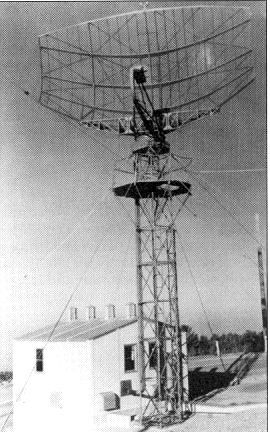
The AN/FPS-8 Radar was a Medium-Range Search Radar used by the United States Air Force Air Defense Command.

The AN/FPS-20 was a widely used L band early warning and ground-controlled interception radar system employed by the United States Air Force Air Defense Command, the NORAD Pinetree Line in Canada, the USAF CONAD in the continental United States, and a variety of other users. The design started life as the Bendix AN/FPS-3 in 1950, was upgraded to the FPS-20, then spawned over a dozen different variants as additional upgrades were applied. The FPS-20 formed the backbone of the US air defense network through the early Cold War with over 200 units deployed. Most FPS-20 sites were replaced by modern equipment in the late 1960s, although a number were turned over to the FAA, modified for air traffic control use, and became ARSR-60s.
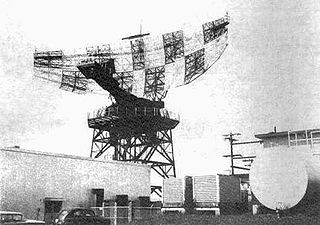
The AN/FPS-24 Radar was a long range early warning radar used by the United States Air Force Air Defense Command. It used a two-frequency signal in order to avoid fluctuation loss, which causes signals on single-frequency radars to fade in and out as the target moves. Reducing this effect results in a much steadier signal.
The Avco AN/FPS-26 Radar was an Air Defense Command height finder radar developed in the Frequency Diversity Program with a tunable 3-cavity power klystron for electronic counter-countermeasures (e.g. to counter jamming). Accepted by the Rome Air Development Center on 20 January 1960 for use at SAGE radar stations, the AN/FPS-26 processed height-finder requests (e.g., from Air Defense Direction Centers) by positioning to the azimuth of a target aircraft using a high-pressure hydraulic drive, then "nodding" in either a default automatic mode or by operator command. The inflatable radome required a minimum pressure to prevent contact with the antenna which would result in damage to both (technicians accessed the antenna deck via an air lock.) To maintain high dielectric strength, the waveguide was pressurized with sulfur hexafluoride (SF6), which technicians were warned would produce deadly fluorine if waveguide arcing occurred.
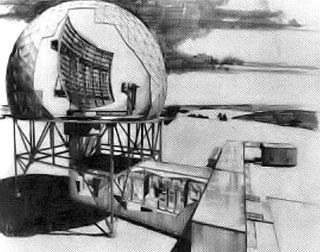
The AN/FPS-27 Radar was a long-range early warning radar used by the United States Air Force Air Defense Command.

The AN/FPS-4 Radar was a Height-Finder Radar used by the United States Air Force Air Defense Command.
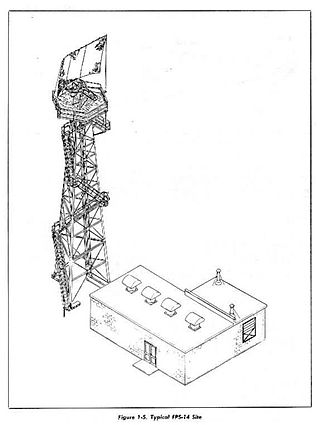
The AN/FPS-14 was a medium-range search Radar used by the United States Air Force Air Defense Command.
The AN/FPS-18 was a medium-range search radar used by the United States Air Force Air Defense Command.

The AN/CPS-6 was an S-band medium-range search/height finder radar used by the United States Air Force Air Defense Command. The radar was developed during the later stages of World War II by the MIT Radiation Laboratory with the first units produced by General Electric in mid-1945. In accordance with the Joint Electronics Type Designation System, the designation represents the 6th design of an Army-Navy air transportable radar(pulsed) electronic device for searching.
The AN/FPS-5 was a nodding height-finding radar used by the United States Air Force Air Defense Command. It was unique in that it used a fixed reflector and a moving feed in order to steer the beam. It was produced in the early 1950s by Hazeltine, and deployment was limited. It was normally used with the AN/FPS-3 search radar.

The AN/FPS-19 was a long-range search radar developed for the NORAD Distant Early Warning Line by Raytheon. It was an L-band system working between 1220 and 1350 MHz produced by a 500 kW magnetron. Two such systems were placed back-to-back, one with an antenna that produced a narrow beam to improve range for long-range detection, and the second with a wider fan-shaped beam to cover higher angles at shorter ranges. The former could detect bomber-sized targets to about 160 miles (260 km) and the latter covered up to 65,000 ft (20,000 m) altitude.
The Bendix AN/FPS-30 was a long-range search radar deployed at Distant Early Warning Line sites in Greenland. It was an advancement over the AN/FPS-19 radars deployed in Alaska and Canada, being optimized for use in severe Arctic conditions. It was planned as a replacement, however cost constraints led to it only being installed at the Greenland DYE sites. In accordance with the Joint Electronics Type Designation System, the radar's designation represents the 30th design of an Army-Navy fixed radar(pulsed) electronic device for searching.
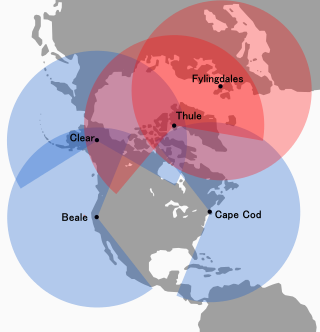
The Solid State Phased Array Radar System (SSPARS), colloquially Ballistic Missile Early Warning System radar network, is a United States Space Force radar, computer, and communications system for missile warning and space surveillance. There are SSPARS systems at five sites: Beale Air Force Base, CA, Cape Cod Space Force Station, MA, Clear Space Force Station, AK, RAF Fylingdales, UK, and Pituffik Space Base, Greenland. The system completed replacement of the RCA 474L Ballistic Missile Early Warning System when the last SSPAR was operational at then-Clear Air Force Station in 2001.
















